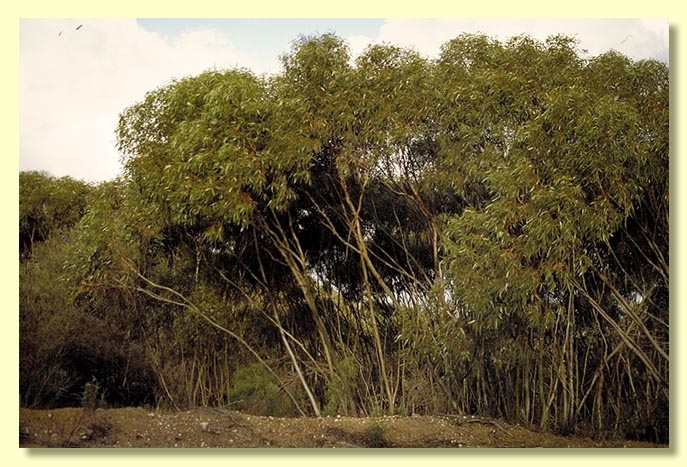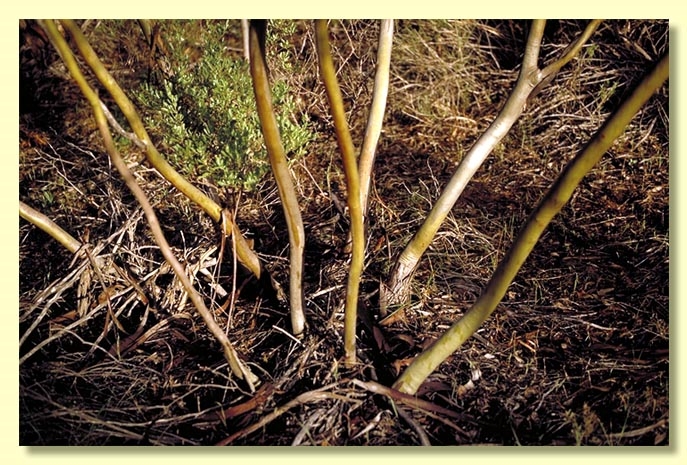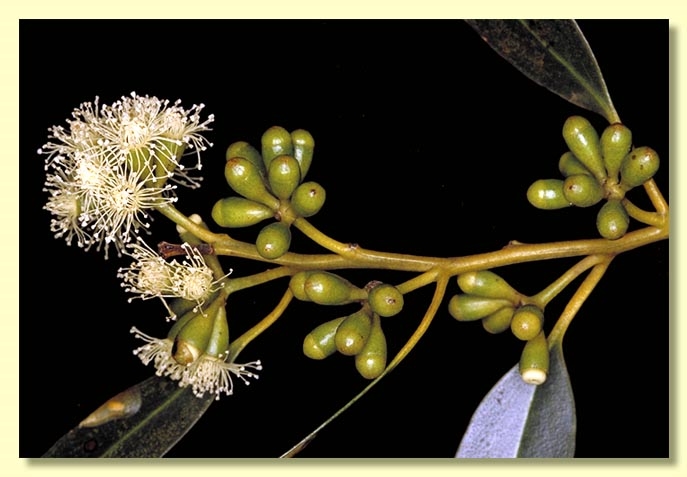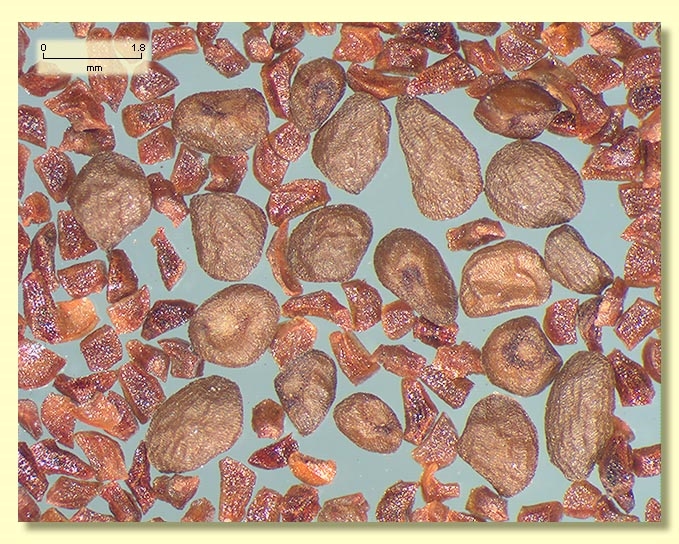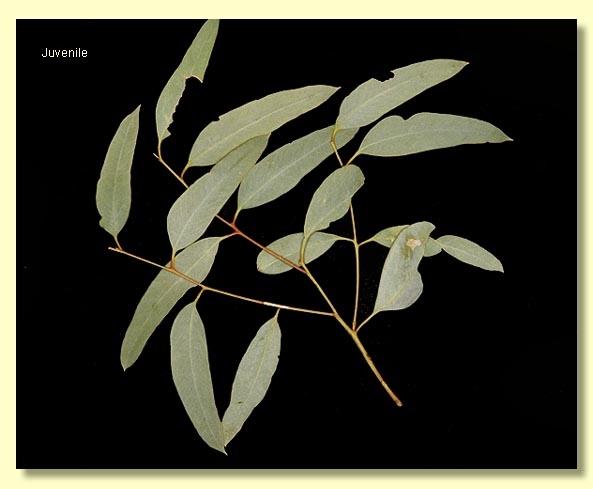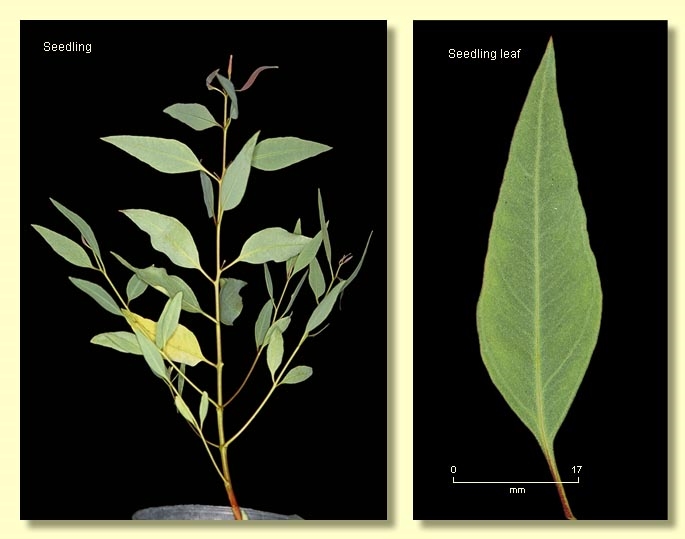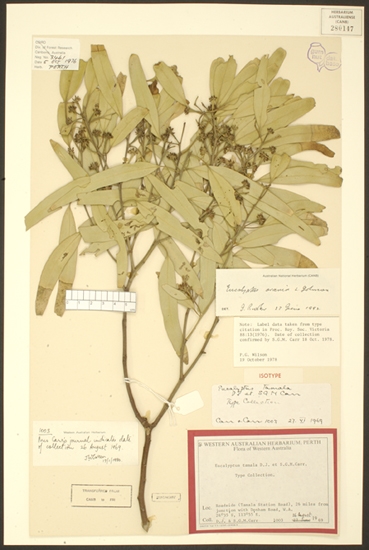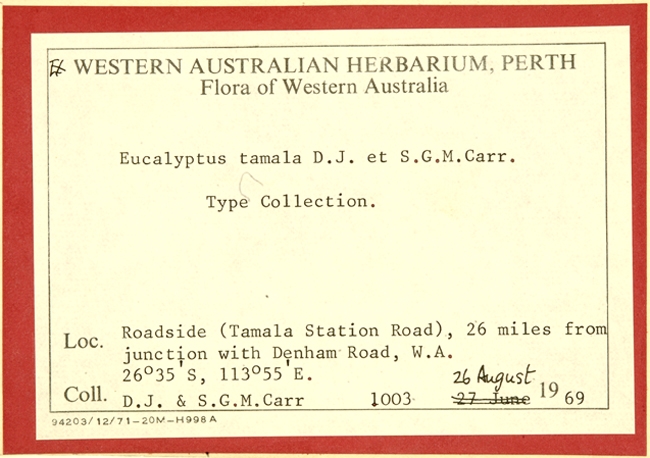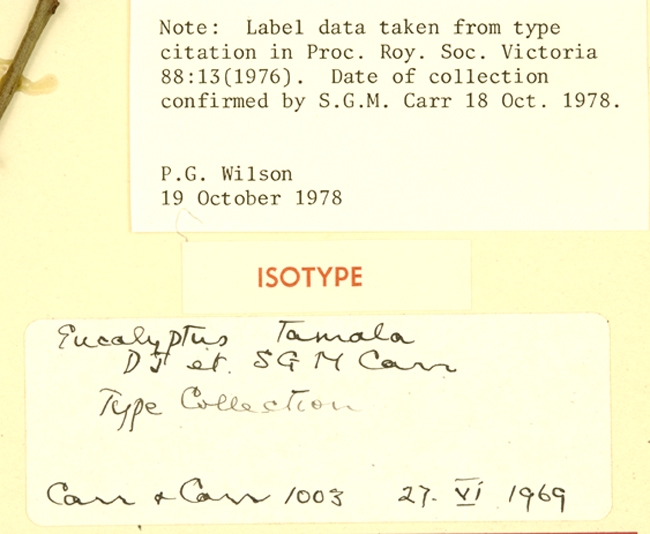Eucalyptus | Symphyomyrtus | Dumaria | Ovulares
Euclid - Online edition
Eucalyptus oraria
T: c. 5 miles [8 km] N of Dongarra, W.A., 10 Dec. 1960, L.A.S.Johnson W33; holo: NSW.
Eucalyptus tamala D.J.Carr & S.G.M.Carr, Trans. Roy. Soc. Victoria 88: 12 (1976). T: Tamala Stn road, 26 miles [c. 42 km] from junction with Denham road, W.A., 26°35'S, 113°55'E, 27 June 1969, D.J. & S.G.M.Carr 1003; holo: PERTH; iso: CANB.
Bark rough only on lower trunk, flaky, grey, or smooth throughout grey-green over yellowish, shedding in strips.
Branchlets have oil glands in the pith, sometimes few or only at the nodes.
Juvenile growth (coppice or field seedlings to 50 cm): stems rounded in cross-section; juvenile leaves always petiolate, alternate, ovate to lanceolate, 5–9 cm long, 1.3–3.5 cm wide, dull, green.
Adult leaves alternate, petioles 0.8–1.5 cm long; blade lanceolate, (5.5)6.5–10(11) cm long, 0.8–2.3 cm wide, base tapering to petiole, margin entire, apex pointed, concolorous, glossy, yellow-green to mid-green, side-veins usually acute, reticulation moderate, broken, intramarginal vein present, oil glands yellow, irregularly-shaped, intersectional.
Inflorescence axillary unbranched, peduncles narrowly flattened, 0.5–1.5 cm long, buds 9 to 19 or more, normally pedicellate, rarely sessile, pedicels (0)0.1–0.3 cm long. Mature buds obovoid (0.45–0.7 cm long, 0.2–0.4 cm wide), scar present (outer operculum shed early), inner operculum rounded and apiculate (0.15–0.2 cm long), stamens inflexed, anthers more or less wedge-shaped, versatile, dorsifixed, dehiscing by longitudinal slits, style long and straight, stigma blunt, locules 3(4), the placentae each with 4 vertical rows of ovules. Flowers white.
Fruit normally pedicellate, rarely sessile, pedicels (0)0.1–0.3 cm long, barrel-shaped often with a tapering base, 0.5–0.8 cm long, 0.4–0.5 cm wide, occasionally with several shallow longitudinal ribs, disc vertically descending, valves 3(4), enclosed.
Seeds grey-brown to yellowish brown, 1–2 mm long, flattened-ovoid often pointed at one end, dorsal surface shallowly and clearly reticulate, hilum ventral.
Cultivated seedlings (measured at node 10): cotyledons reniform; stems square in cross-section; leaves petiolate, opposite for 6–8 nodes then alternate, ovate to lanceolate, 5–9.5 cm long, 1.5–3 cm wide, dull blue-green.
Flowering has been recorded in May, August, September and October.
A coastal or near-coastal mallee on calcareous sands. It is endemic to Western Australia and is found from Cataby Brook and Jurien north to Dongarra, Kalbarri and Shark Bay area (Tamala Station and offshore islands, e.g. Dirk Hartog and Dorre Islands
Eucalyptus oraria belongs in Eucalyptus subgenus Symphyomyrtus section Dumaria because the buds have two opercula, stamens are strongly inflexed, ovules are in four rows on the placentae and cotyledons are reniform. Within section Dumaria it belongs to a small subgroup of nine closely related species, series Ovulares. The series is further diagnosed by glandular pith, cuboid anthers, and seeds with a brown shallowly and clearly reticulate dorsal seedcoat.
Some of the species in series Ovulares are completely smooth-barked (E. cyclostoma, E. cylindrocarpa, E. exigua and smaller plants of E. oraria) while others (E. aequioperta, E. baudiniana, E. comitae-vallis, E. myriadena and E. ovularis) have rough bark over at least part of the stems.
Within its home range the mallee E. oraria is likely to be confused only with E. baudiniana. E. oraria has larger shortly pedicellate to sessile fruit and is mostly smooth-barked compared to E. baudiniana. Plants of E. oraria with a gnarled tree habit are known from Tamala, whilst on Dorre Island the species occurs as a low shrub to 1 m tall.

